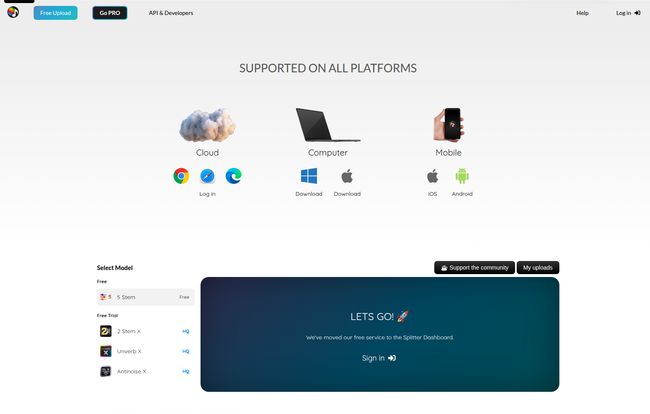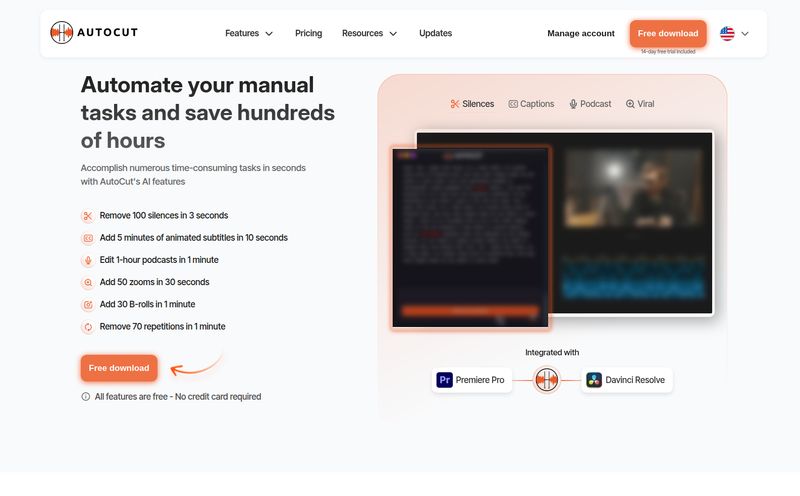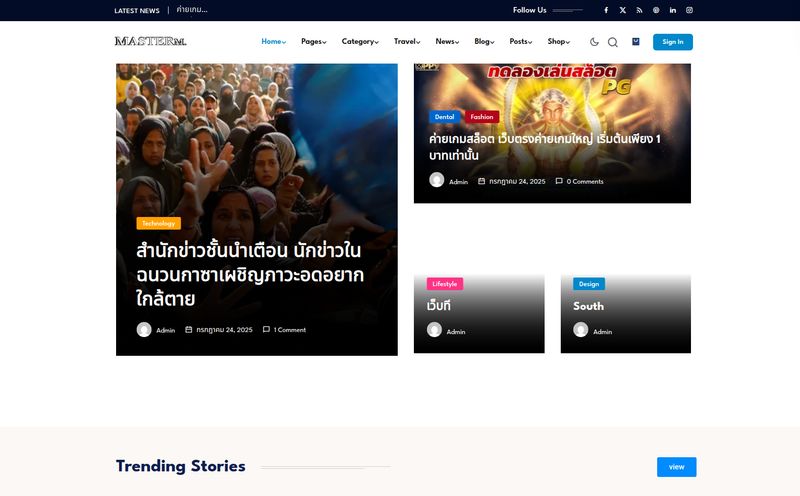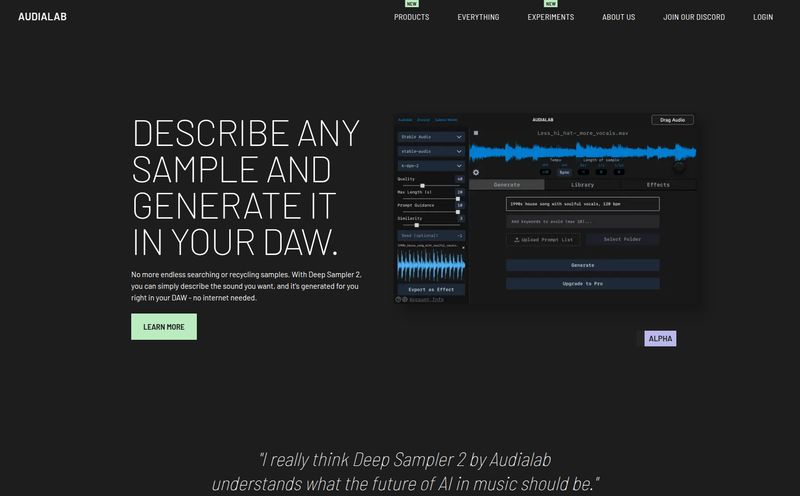For years, I've been hearing the same old story from producers, DJs, and even my fellow content creators. It usually starts with, “If only I could get the vocals from this track…” or “Man, I wish I could remove the drums and just have that bassline.” We’ve all been there, right? Trying those clunky, old-school phase-inversion tricks in Audacity that kinda-sorta worked but left everything sounding like it was recorded in a fish tank.
It was a pipe dream. A holy grail. The kind of thing you’d need a high-end studio and the original master tapes for.
Well, the game has changed. Drastically. I’ve been playing around with a tool that feels less like software and more like some kind of dark magic, and I have to tell you about it. It’s called Splitter.ai, and it’s been quietly revolutionizing workflows for a whole bunch of people, from bedroom producers to, get this, Hollywood sound designers.

Visit Splitter.ai
So, What Exactly is Splitter.ai?
At its core, Splitter.ai is an AI-powered audio processing platform. That's the fancy way of saying it's a super-smart robot that can listen to a finished song and… well, un-finish it. It uses complex machine-learning models to identify and separate the different instruments in a piece of music. Think of it like giving an AI a fully baked cake and asking it to pull out the flour, the eggs, and the sugar, all perfectly intact. It sounds impossible, but here we are.
This isn't just some fly-by-night startup, either. It’s the brainchild of a Swedish research company that's deep in the audio tech weeds. Their technology has apparently been used in major films like Fast & Furious 7 and Men in Black: International. So yeah, it's got some serious street cred.
Unpacking the AI Magic - How It All Works
Instead of just filtering frequencies (the old, clumsy way), Splitter’s AI has been trained on mountains of musical data. It has learned what a drum sounds like, what a human voice sounds like, the specific textures of a bass guitar versus a piano. It hears the song as a whole and then uses that knowledge to surgically extract each part, or “stem.”
The result? You can upload a standard MP3 or WAV file and get back separate audio files for:
- Vocals
- Drums
- Bass
- Piano
- And the rest of the instruments (guitars, synths, etc.)
Suddenly, you have the building blocks to do almost anything. It's a level of control that was, until very recently, completely out of reach for the average person. Pretty wild, huh?
The Features That Actually Matter
Okay, so it pulls songs apart. Cool. But the platform's flexibility is where it really shines. It’s not just a one-trick pony.
The Different AI Models
Splitter offers a few different processing models depending on what you need. Their main one is the 5-Stem model, which gives you vocals, drums, bass, piano, and 'other'. This is fantastic for detailed remixing or analysis. But they also have a higher-quality 2-Stem model (in the PRO version) that just splits a track into vocals and instrumental. Perfect for creating acapellas or karaoke-ready backing tracks with incredible clarity.
And it's not just about splitting. They also have dedicated models like Unverb X to remove reverb from a recording (a lifesaver for cleaning up dialogue or vocals) and Antinoise X for general noise reduction. It’s becoming a full-fledged audio repair kit.
Cloud Convenience or Local Control
One of the things I appreciate is the choice in how you use it. You can simply use their website to upload a file to the Cloud for processing. It’s easy, requires no installation, and works on any device. For more serious work, they offer Splitter Studio, a downloadable application for your computer. This gives you local processing power, which means no waiting in queues and more control right on your desktop. It's great to see support for Windows, Mac, iOS, and Android, covering basically everyone.
The All-Important Free vs. PRO Discussion
Let's be real, the first question is always, “how much does it cost?” Splitter.ai cleverly operates on a freemium model. The free service is genuinely useful. You can use the 5-stem model and get a feel for the technology without pulling out your credit card. For anyone curious, this is the perfect place to start.
The PRO version, however, is where the professional-grade features are. We’re talking higher quality audio output, access to the best 2-stem model, faster processing, and a killer feature for DJs and remix artists: direct splitting from a YouTube link. No more dodgy YouTube-to-MP3 converters needed. You just paste the link and let the AI do its thing.
Who Is This Audio Scalpel Really For?
The list of potential users here is huge, and I’m probably only scratching the surface.
- Music Producers: This is a no-brainer. Grab a vocal you love to build a new track around. Sample a drum break with perfect isolation. Learn how your favorite songs are constructed by listening to each instrument on its own. It's an educational tool and a creative powerhouse all in one.
- DJs: Create custom acapellas and instrumentals for live mashups and remixes on the fly. The YouTube-to-stem feature is a game-changer for this alone.
- Karaoke Enthusiasts: Turn literally any song into a karaoke track. Your next party just got a major upgrade.
- Musicians: Isolate the bass or guitar part of a song to learn it more easily. Create backing tracks to practice with.
- Content Creators: Need to clean up some dialogue? Or want to use a piece of music in your video but the vocals are distracting? Problem solved.
- Forensics and Law Enforcement: This one is wild. The website mentions police and forensic engineers as users. I can only imagine they're using it to isolate voices or clean up noisy surveillance audio. Fascinating stuff.
My Honest Take: The Good, The Bad, and The AI
I’ve run a bunch of tracks through it, and I’m genuinely impressed. The quality of the separation is, most of the time, shockingly good. Of course, it’s not perfect. No AI is. Complex, dense tracks can sometimes result in minor audio artifacts—a little bit of a cymbal “hiss” bleeding into the vocal track, for example. But it's miles ahead of anything I've tried before.
The biggest upside is the sheer accessibility. It democratizes a process that used to be incredibly exclusive and expensive. The free tier is generous enough to be truly functional.
On the flip side, the free cloud processing can sometimes have a queue, so you might have to wait a bit for your track. And of course, we have to talk about the elephant in the room: copyright. The platform itself warns you to be careful. Just because you can create a perfect acapella of a famous song doesn't mean you can legally release a remix of it without permission. Use this tool creatively and responsibly. Think of it as a tool for personal learning, private DJ sets, or for working with your own original material.
Let's Talk About Pricing
As I mentioned, there's a fantastic free offering. For the PRO plan, the pricing details are available directly on their site. Since they're always updating features and plans, your best bet is to head over to their website and click the "Go PRO" button to see the latest offerings. I won't post a price here because it'll probably be outdated by next month, but it's subscription-based and aimed at folks who will be using this regularly in their workflow.
Frequently Asked Questions
Is it legal to use Splitter.ai?
Using the tool itself is perfectly legal. How you use the output is what matters. Using it to learn a song part or for a private DJ mix is generally fine. Releasing a bootleg remix of a major artist's song without clearing the rights is copyright infringement. Always be smart and respectful of copyright law.
Can I really use any song?
Yes, you can upload almost any standard audio file (MP3, WAV, FLAC, etc.). The AI will attempt to process it. The quality of the separation can vary depending on how the original track was mixed and mastered. A clean, well-defined mix will generally yield better results than a very dense or heavily distorted one.
What's the main difference between the 2-stem and 5-stem models?
The 5-stem model is designed to break a song into five parts: vocals, drums, bass, piano, and other instruments. It's great for deep analysis or complex remixing. The 2-stem model focuses only on creating the highest-quality separation between the full instrumental track and the vocal track (acapella).
Do I have to download software to use it?
Nope! You can use the cloud-based version directly on the Splitter.ai website by just uploading your file. The Splitter Studio software is an optional download for users who want to process files locally on their own computer for more speed and control.
Final Thoughts: A Tool That Sparks Creativity
So, is Splitter.ai the ultimate cheat code? In a way, yeah. It removes technical barriers that have stood in the way of creativity for decades. It’s an incredible learning aid, a powerful remixing tool, and a genuinely useful audio utility.
While the pro version holds the most power, the free version is a testament to the company's confidence in their tech. They give you enough to see the magic for yourself, knowing you'll be impressed. If you're involved in music or audio in any capacity, you owe it to yourself to give it a try. Go upload a track, pull it apart, and see what ideas it sparks. You might be surprised.
Reference and Sources
For the most up-to-date information and to try the tool yourself, visit the official website:



